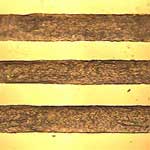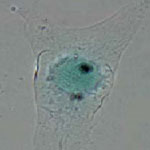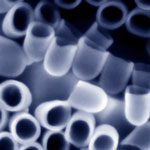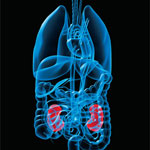Showing Spotlights 153 - 160 of 318 in category All (newest first):
 Increasing the efficiencies of polymer-based solar cells while at the same time keeping production complexity and cost low will require the preparation of new classes of polymers that can be prepared with a minimum of synthetic steps. Combining strong electron acceptors such as fullerenes (C60) with commodity polymers to make electronically active polymers promises to be one possible route. So far, though, the photovoltaic efficiencies of polymer/C60 blends are generally not as good as those for photovoltaic devices made from the currently used main classes of polymers, P3HT and PCBM. Researchers in France came up with a way to very simply prepare polymers from fullerenes without having to strongly change the aromaticity of the C60 sphere. This means that many of the original properties of C60 may be found to be retained even when combined with the beneficial properties of polymers.
Increasing the efficiencies of polymer-based solar cells while at the same time keeping production complexity and cost low will require the preparation of new classes of polymers that can be prepared with a minimum of synthetic steps. Combining strong electron acceptors such as fullerenes (C60) with commodity polymers to make electronically active polymers promises to be one possible route. So far, though, the photovoltaic efficiencies of polymer/C60 blends are generally not as good as those for photovoltaic devices made from the currently used main classes of polymers, P3HT and PCBM. Researchers in France came up with a way to very simply prepare polymers from fullerenes without having to strongly change the aromaticity of the C60 sphere. This means that many of the original properties of C60 may be found to be retained even when combined with the beneficial properties of polymers.
May 29th, 2009
 Theoretical studies have long predicted that the exceptional physical and chemical properties of a rigid monatomic linear chain of carbon atoms could function as the component of molecular devices, for instance in nanoelectronics. The problem has been that there was no reliable and effective way to produce these carbon chains and therefore scientists couldn't study them experimentally. While linear carbon chains have been already prepared either in solution or by vaporizing graphite, researchers in Japan have for the first time succeeded to derive the carbon atomic chains from graphene in a well controlled manner. This approach to realize freestanding carbon atomic chains employs energetic electron irradiation inside a transmission electron microscope.
Theoretical studies have long predicted that the exceptional physical and chemical properties of a rigid monatomic linear chain of carbon atoms could function as the component of molecular devices, for instance in nanoelectronics. The problem has been that there was no reliable and effective way to produce these carbon chains and therefore scientists couldn't study them experimentally. While linear carbon chains have been already prepared either in solution or by vaporizing graphite, researchers in Japan have for the first time succeeded to derive the carbon atomic chains from graphene in a well controlled manner. This approach to realize freestanding carbon atomic chains employs energetic electron irradiation inside a transmission electron microscope.
May 28th, 2009
 In a previous Nanowerk Spotlight we have reported about the work of Chinese scientists who demonstrated that a sheet of carbon nanotube (CNT) thin film could be a practical magnet-free loudspeaker simply by applying an audio frequency current through it . The team has now reported that their CNT films can also work as an incandescent display, driven by a simple addressing circuit with response times faster than that of liquid crystal displays (LCDs). At the same time, the incandescent light of the CNT film is almost nonpolarized, and will not have the viewing-angle problem of LCDs. The CNT films in vacuum can be heated to incandescence and cooled down in about 1 millisecond by turning on and shutting off the heating voltage.
In a previous Nanowerk Spotlight we have reported about the work of Chinese scientists who demonstrated that a sheet of carbon nanotube (CNT) thin film could be a practical magnet-free loudspeaker simply by applying an audio frequency current through it . The team has now reported that their CNT films can also work as an incandescent display, driven by a simple addressing circuit with response times faster than that of liquid crystal displays (LCDs). At the same time, the incandescent light of the CNT film is almost nonpolarized, and will not have the viewing-angle problem of LCDs. The CNT films in vacuum can be heated to incandescence and cooled down in about 1 millisecond by turning on and shutting off the heating voltage.
May 22nd, 2009
 The prospect of stretchable electronics opens some exciting possibilities - for instance, think about artificial skin with an integrated, stretchable touchscreen display. To get there, researchers have begun developing elastic electrical wiring that is both highly conductive and highly stretchable. Currently existing stretchable materials do already exhibit excellent conductivity and mechanical stretchability but they have one major disadvantage: their manufacturing processes are not readily scalable, which means it is difficult or cost-prohibitive to apply them to large-area electronics. A research team in Japan has now successfully fabricated, for the first time, novel elastic conductors that can be directly patterned by printing processes. This novel, printable elastic conductor comprises single-walled carbon nanotubes uniformly dispersed in a highly elastic fluorinated copolymer rubber.
The prospect of stretchable electronics opens some exciting possibilities - for instance, think about artificial skin with an integrated, stretchable touchscreen display. To get there, researchers have begun developing elastic electrical wiring that is both highly conductive and highly stretchable. Currently existing stretchable materials do already exhibit excellent conductivity and mechanical stretchability but they have one major disadvantage: their manufacturing processes are not readily scalable, which means it is difficult or cost-prohibitive to apply them to large-area electronics. A research team in Japan has now successfully fabricated, for the first time, novel elastic conductors that can be directly patterned by printing processes. This novel, printable elastic conductor comprises single-walled carbon nanotubes uniformly dispersed in a highly elastic fluorinated copolymer rubber.
May 20th, 2009
 New work at the University of Arkansas has, for the very first time, demonstrated that Raman spectroscopy can be used to detect and monitor circulating carbon nanotubes in vivo and in real time. These findings could have a significant impact on the knowledge of how nanomaterials interact with living biological systems. Carbon nanotubes can be used for various advanced bio-medical applications. Before any clinical application of nanoparticles, it is imperative to determine critical in vivo parameters, namely pharmacological profiles including nanoparticle clearance rate from the circulation and their biodistribution in various tissue and organs. Until now, their distribution was only monitored by collecting samples after various time intervals, but this new research shows the ability of monitoring their concentration in vivo and in real time, while the animal is alive. Moreover, this work can be extended to the detection of circulating cancer cells that have been tagged by carbon nanotubes.
New work at the University of Arkansas has, for the very first time, demonstrated that Raman spectroscopy can be used to detect and monitor circulating carbon nanotubes in vivo and in real time. These findings could have a significant impact on the knowledge of how nanomaterials interact with living biological systems. Carbon nanotubes can be used for various advanced bio-medical applications. Before any clinical application of nanoparticles, it is imperative to determine critical in vivo parameters, namely pharmacological profiles including nanoparticle clearance rate from the circulation and their biodistribution in various tissue and organs. Until now, their distribution was only monitored by collecting samples after various time intervals, but this new research shows the ability of monitoring their concentration in vivo and in real time, while the animal is alive. Moreover, this work can be extended to the detection of circulating cancer cells that have been tagged by carbon nanotubes.
May 12th, 2009
 Many nanotechnology research efforts have explored the use of hollow nanochannels formed by carbon nanotubes (CNTs). However, the usually large length/diameter aspect ratio of CNTs has made it challenging to insert other materials into them in a controlled manner. A team of scientists has now developed the idea of using a nanocup morphology to solve this problem. The length/diameter ratio of these new graphitic architectures is 1,000 to 100,000 times smaller compared to conventional carbon nanotubes. This will allow researchers to build highly engineered and multicomponent functional nano building blocks for various applications including nanomedicine and nanometrology.
Many nanotechnology research efforts have explored the use of hollow nanochannels formed by carbon nanotubes (CNTs). However, the usually large length/diameter aspect ratio of CNTs has made it challenging to insert other materials into them in a controlled manner. A team of scientists has now developed the idea of using a nanocup morphology to solve this problem. The length/diameter ratio of these new graphitic architectures is 1,000 to 100,000 times smaller compared to conventional carbon nanotubes. This will allow researchers to build highly engineered and multicomponent functional nano building blocks for various applications including nanomedicine and nanometrology.
May 11th, 2009
 Online breath analysis via an array of chemiresistive random network of single walled carbon nanotubes coated with organic materials showed excellent discrimination between the various breath states. An important implication of these findings, besides the detection of diseases directly related to the respiratory, cardiovascular, and renal systems, is the fact that volatile organic compounds are mainly blood borne and the concentration of biologically relevant substances in exhaled breath closely reflects that in the arterial system. Therefore, breath is predestined for monitoring different processes in the body. The excellent discrimination between the various breath states obtained in this study provides expectations for future capabilities for diagnosis, detection, and screening various stages of kidney disease, especially in the early stages of the disease, where it is possible to control blood pressure, fat, glucose and protein intake to slow the progression.
Online breath analysis via an array of chemiresistive random network of single walled carbon nanotubes coated with organic materials showed excellent discrimination between the various breath states. An important implication of these findings, besides the detection of diseases directly related to the respiratory, cardiovascular, and renal systems, is the fact that volatile organic compounds are mainly blood borne and the concentration of biologically relevant substances in exhaled breath closely reflects that in the arterial system. Therefore, breath is predestined for monitoring different processes in the body. The excellent discrimination between the various breath states obtained in this study provides expectations for future capabilities for diagnosis, detection, and screening various stages of kidney disease, especially in the early stages of the disease, where it is possible to control blood pressure, fat, glucose and protein intake to slow the progression.
May 7th, 2009
 The use of gold nanoparticles in numerous biological and chemical nanotechnology applications experiences limitations due to the stability of the particles and their tendency for non-specific binding. One method to overcome these problems has been the use of carbon nanoshells to encapsulate gold and other noble metal particles. A graphene-like carbon shell is ideal for surface passivation of the metal nanoparticles for several reasons: it is nonreactive with the metallic surface; it provides unsurpassed stability; and it possesses a convenient handle for functionalization. A research team in the U.S. has now demonstrated a new fabrication method to encapsulate gold nanoparticles in a graphene-like carbon shell.
The use of gold nanoparticles in numerous biological and chemical nanotechnology applications experiences limitations due to the stability of the particles and their tendency for non-specific binding. One method to overcome these problems has been the use of carbon nanoshells to encapsulate gold and other noble metal particles. A graphene-like carbon shell is ideal for surface passivation of the metal nanoparticles for several reasons: it is nonreactive with the metallic surface; it provides unsurpassed stability; and it possesses a convenient handle for functionalization. A research team in the U.S. has now demonstrated a new fabrication method to encapsulate gold nanoparticles in a graphene-like carbon shell.
Apr 28th, 2009
 Increasing the efficiencies of polymer-based solar cells while at the same time keeping production complexity and cost low will require the preparation of new classes of polymers that can be prepared with a minimum of synthetic steps. Combining strong electron acceptors such as fullerenes (C60) with commodity polymers to make electronically active polymers promises to be one possible route. So far, though, the photovoltaic efficiencies of polymer/C60 blends are generally not as good as those for photovoltaic devices made from the currently used main classes of polymers, P3HT and PCBM. Researchers in France came up with a way to very simply prepare polymers from fullerenes without having to strongly change the aromaticity of the C60 sphere. This means that many of the original properties of C60 may be found to be retained even when combined with the beneficial properties of polymers.
Increasing the efficiencies of polymer-based solar cells while at the same time keeping production complexity and cost low will require the preparation of new classes of polymers that can be prepared with a minimum of synthetic steps. Combining strong electron acceptors such as fullerenes (C60) with commodity polymers to make electronically active polymers promises to be one possible route. So far, though, the photovoltaic efficiencies of polymer/C60 blends are generally not as good as those for photovoltaic devices made from the currently used main classes of polymers, P3HT and PCBM. Researchers in France came up with a way to very simply prepare polymers from fullerenes without having to strongly change the aromaticity of the C60 sphere. This means that many of the original properties of C60 may be found to be retained even when combined with the beneficial properties of polymers.
 Subscribe to our Nanotechnology Spotlight feed
Subscribe to our Nanotechnology Spotlight feed





